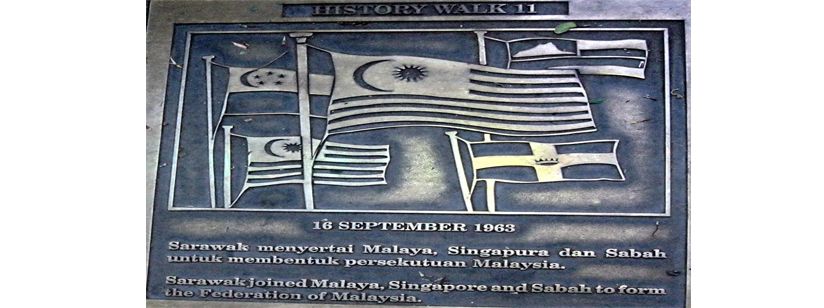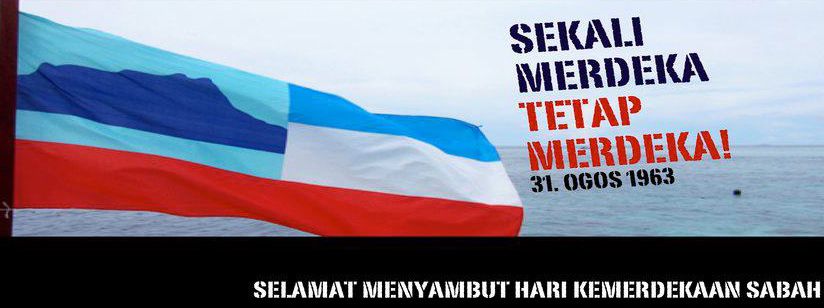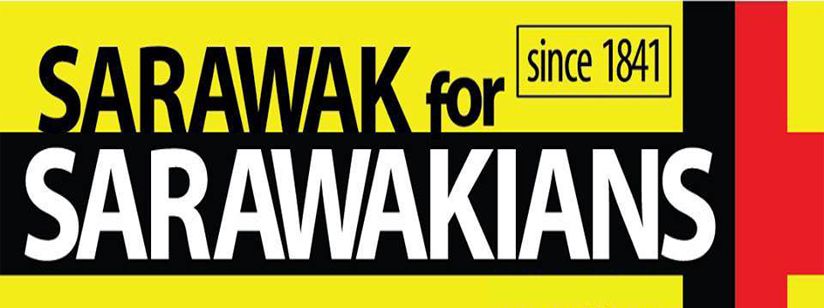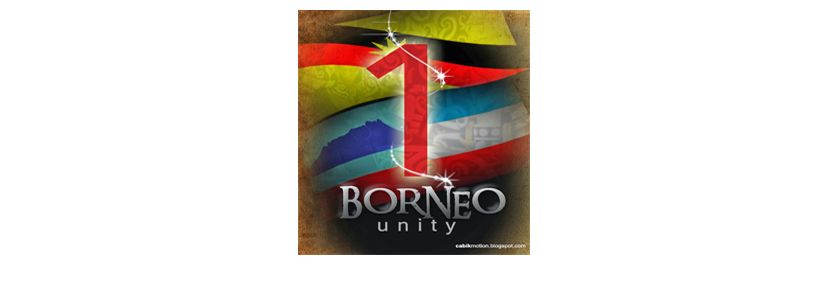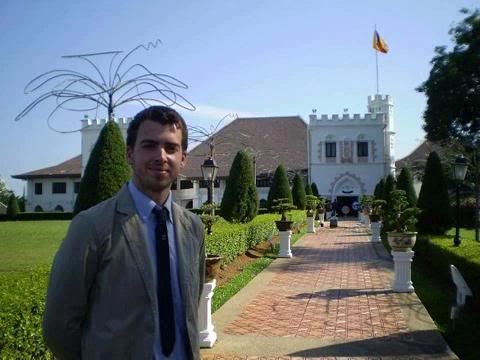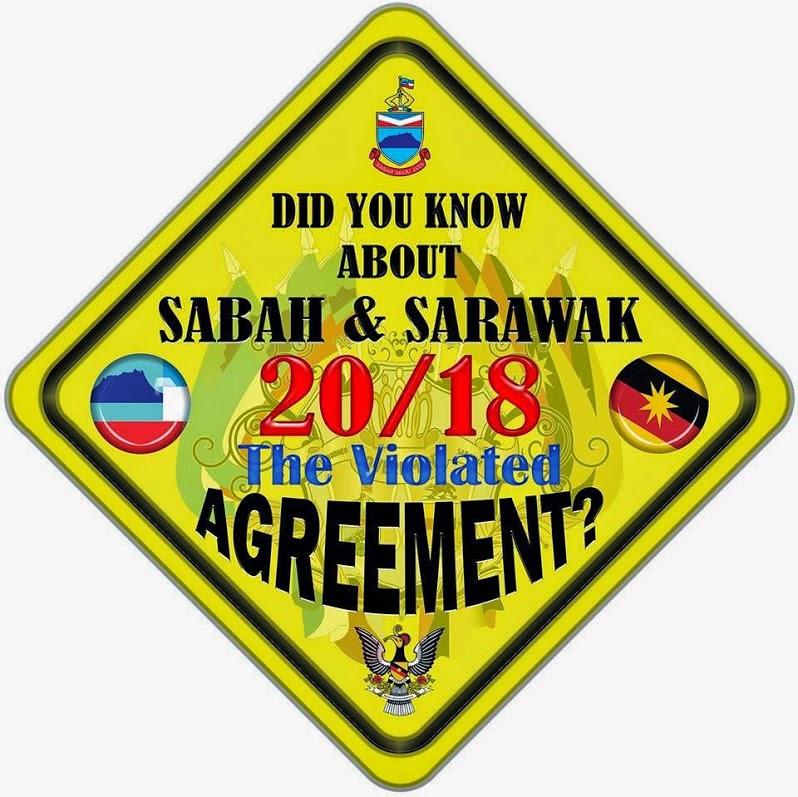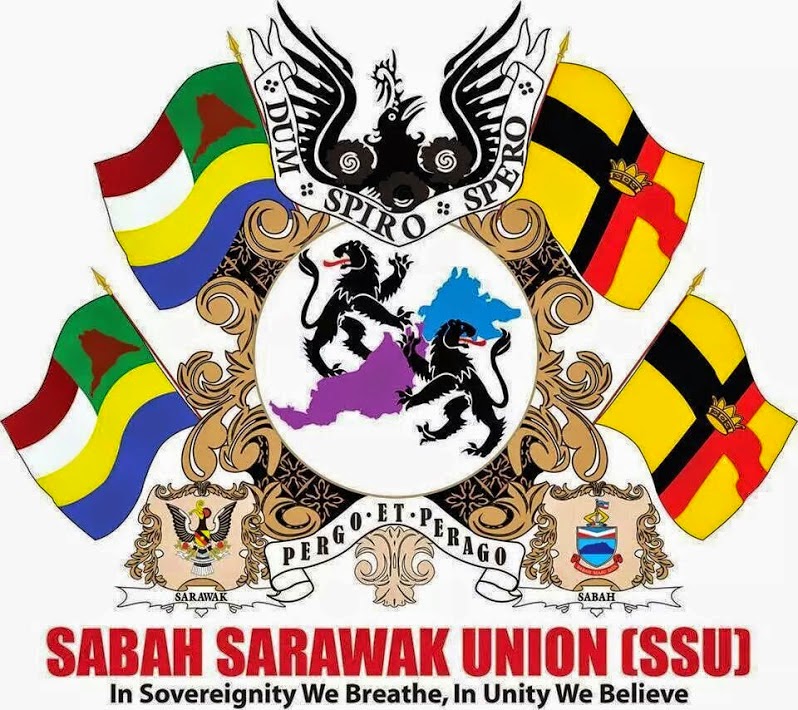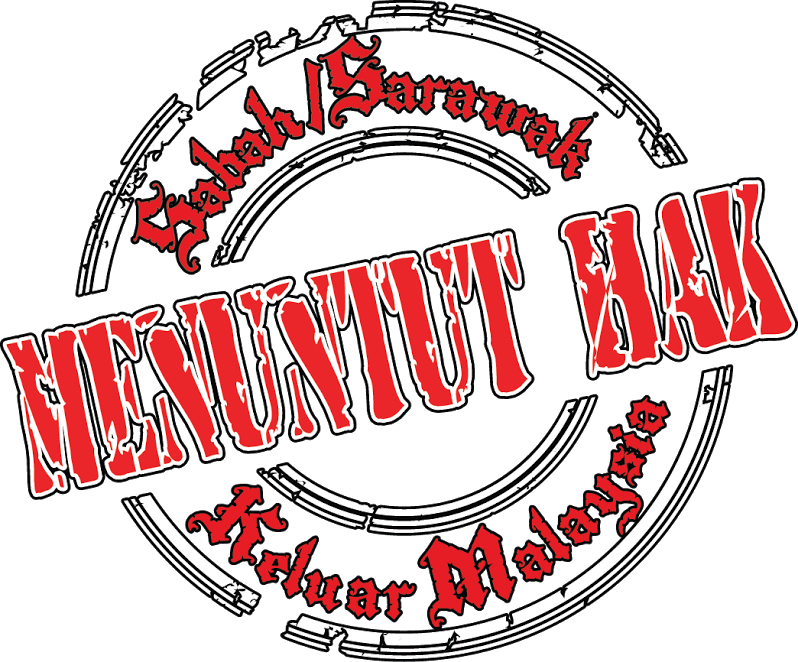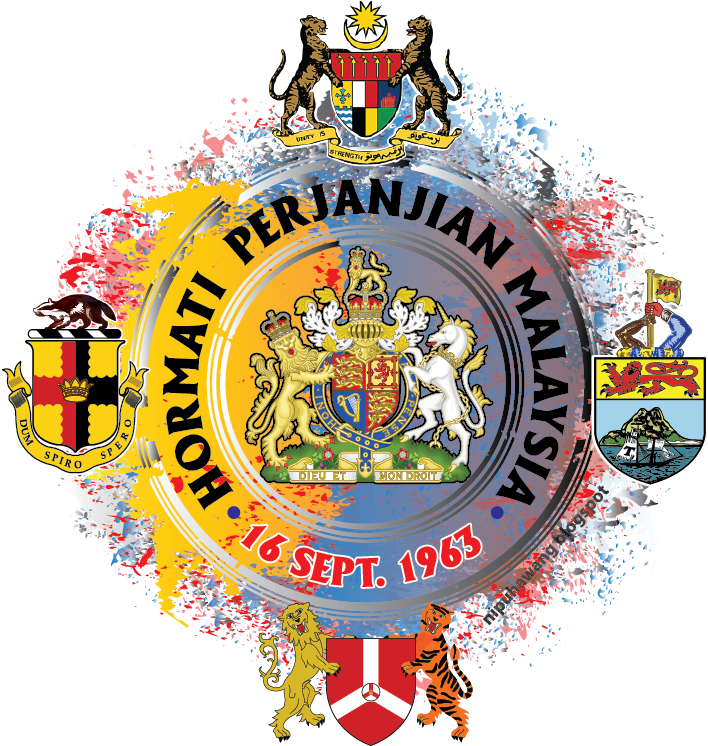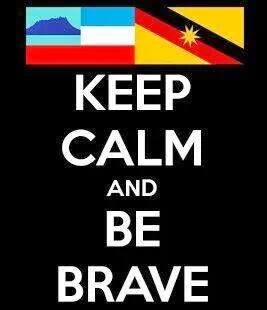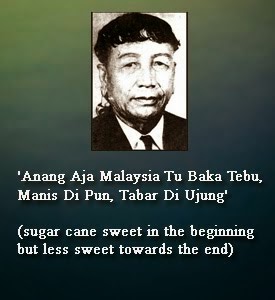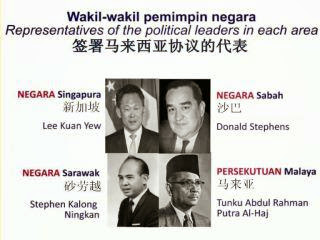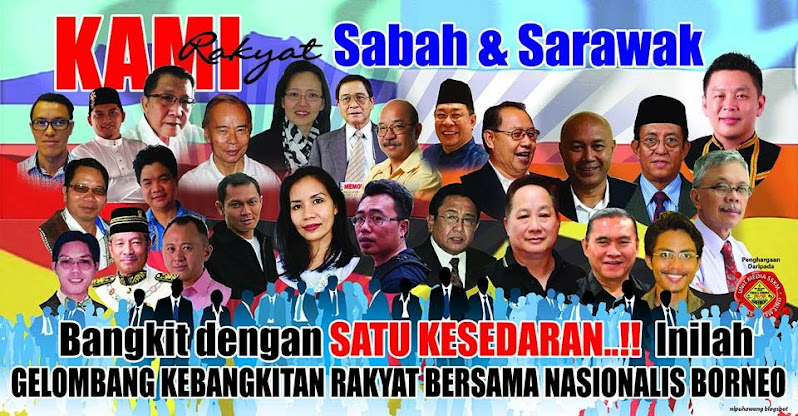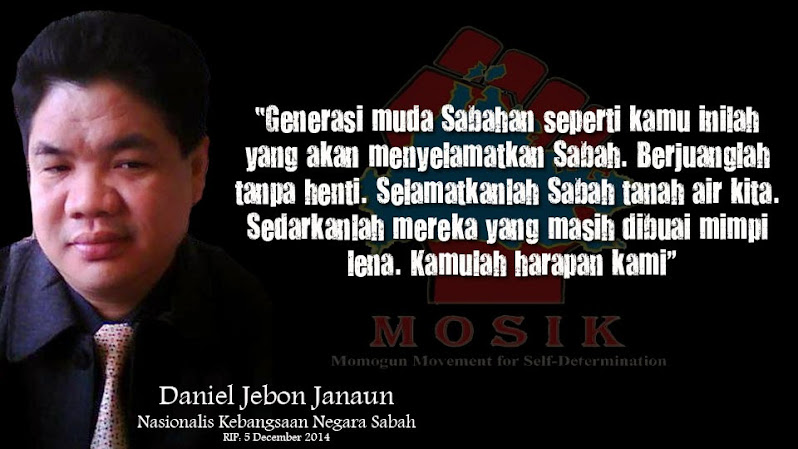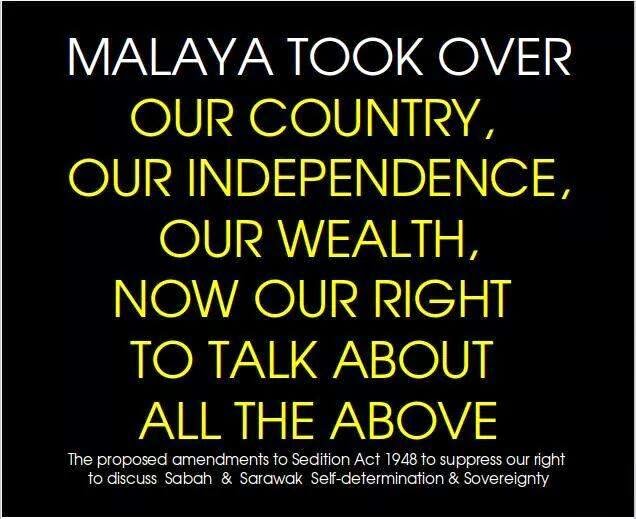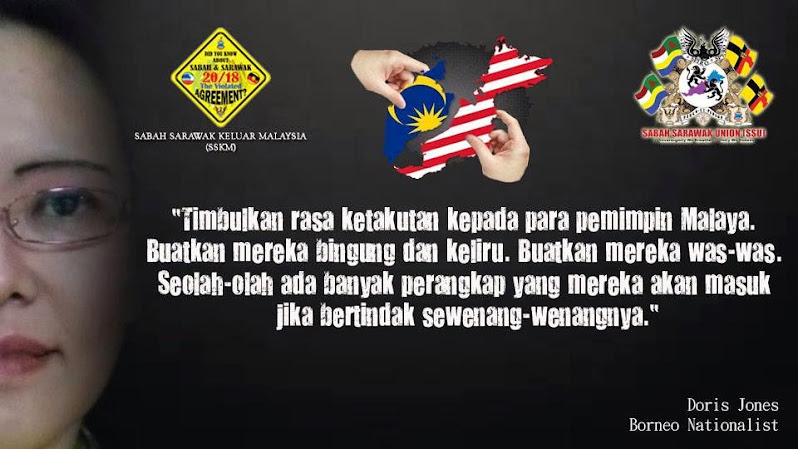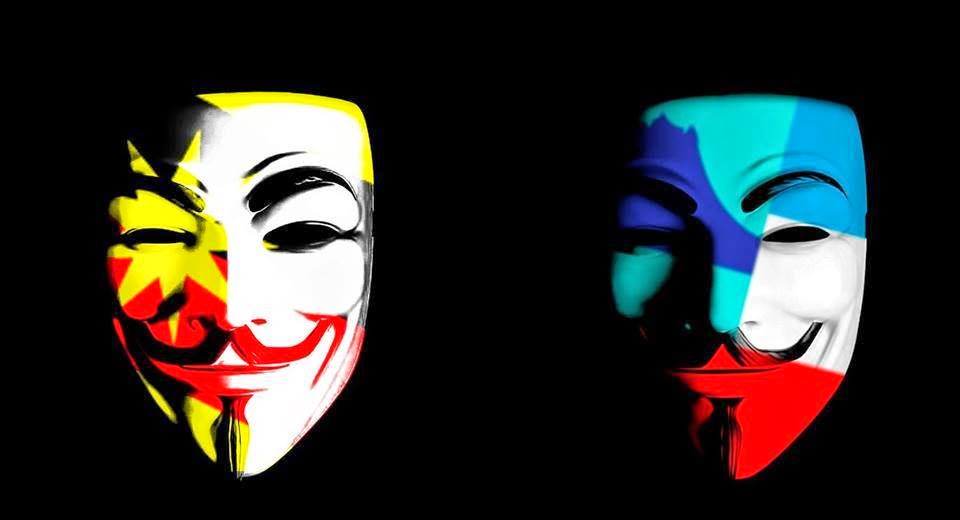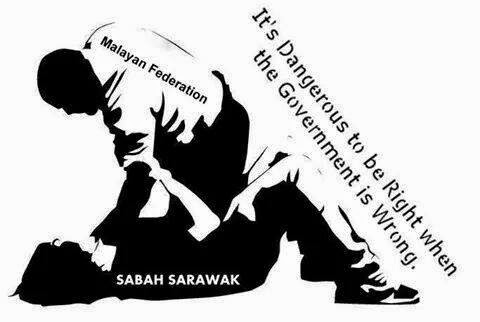Monday 31 December 2012
Monday 24 December 2012
Monday, December 24, 2012
Federation of Malaysia 16 September 1963
,
International
,
North Borneo
,
Sarawak
2
comments
Merry X'Mas to all Borneon!
Tuesday 18 December 2012
Tuesday, December 18, 2012
18 Points
,
20 Points
,
Agreement of Malaysia
,
Sabah
,
Sarawak
,
SSKM
1 comment
SARAWAKIAN & SABAHAN DEMAND FOR OUR RIGHTS
Thursday 8 November 2012
Letter from Wallace 1855 - in Sarawak, Borneo
Original now in the library of The Natural History Museum (London)
In February 1855 whilst staying in a small house in Sarawak, Borneo, Wallace wrote what was probably the most important paper on evolution prior to the discovery of natural selection. Wallace's "Sarawak Law " paper made such an impression on the famous geologist Charles Lyell that in November 1855, soon after reading it, he started writing his "species notebook" in which he began to contemplate the implications of evolutionary change. In April 1856 Lyell paid a visit to Darwin at Down House, and Darwin explained his theory of natural selection to Lyell for the first time: a theory which Darwin had been working on, more or less in secret, for about 20 years. Soon afterwards Lyell sent a letter to Darwin urging him to publish the theory lest someone beat him to it (he probably had Wallace in mind!) and in May 1856 Darwin heeding this advice, began to write a "sketch" of his ideas for publication. This "sketch" was abandoned in about October 1856 and Darwin instead began to write an extensive book about evolution.
In February 1858 Wallace was suffering from an attack of fever in the village of Dodinga on the remote Indonesian island of Halmahera when suddenly the idea of natural selection as the mechanism of evolutionary change occurred to him. As soon as he had sufficient strength he wrote an detailed essay explaining his theory and sent it together with a covering letter to Charles Darwin, who he knew from correspondence was interested in the subject of evolution. He asked Darwin to pass the essay on to Charles Lyell if Darwin thought it was sufficiently interesting:- no doubt hoping that Lyell would help to ensure that it was published in a good journal. Lyell (who Wallace had never corresponded with) was one of the most respected scientists of the time and Wallace must have thought that he would be interested in reading his new theory because it explained the "laws" which Wallace had proposed in his "Sarawak Law" paper. Darwin had mentioned in a letter to Wallace that Lyell had found Wallace's 1855 paper noteworthy.
Unbeknownst to Wallace, Darwin had of course discovered natural selection many years earlier. He was therefore horrified when he received Wallace's letter and immediately appealed to his influential friends Lyell and Joseph Hooker for advice on what to do. Lyell and Hooker decided to present Wallace's essay (without first asking his permission!), along with two unpublished excerpts from Darwin's writings on the subject, to a meeting of the Linnean Society of London on 1 July 1858. These documents were published together in the Society's journal on 20 August of the same year as the paper "On the Tendency of Species to Form Varieties; And On the Perpetuation of Varieties and Species by Natural Means of Selection". Darwin's contributions were placed before Wallace's essay, thus emphasising Darwin's priority to the idea. Wallace later remarked that the paper "was printed without my knowledge, and of course without any correction of proofs", contradicting Lyell and Hooker's statement in their introduction to the joint papers that "both authors...[have]...unreservedly placed their papers in our hands". This unfortunate event prompted Darwin to abandon writing his big book on evolution and instead produce an "abstract" of what he had written up until that point. This "abstract" was published fifteen months later in November 1859 as his famous book On the Origin of Species.
Wallace's discovery of natural selection occurred almost at the midpoint of his stay in the Malay Archipelago. He was to remain there four more years, and by the end of his trip (and for the rest of his life) he was known as the greatest living authority on the region. He was especially known for his studies on its zoogeography, including his discovery and description of the faunal discontinuity that now bears his name. The "Wallace Line," extends between the islands of Bali and Lombok and Borneo and Sulawesi, and marks the limits of eastern extent of many Asian animal species and, conversely, the limits of western extent of many Australasian animals.
Wallace returned to England in 1862 and in the spring of 1866 he married Annie, the twenty-year-old daughter of his friend the botanist William Mitten. Two of their children, Violet and William, survived to adulthood (a third died in infancy).
Wallace spent the rest of his long life popularising the theory of natural selection and working on a very wide variety of other subjects. He wrote more than 700 articles and 22 books, the best known being The Malay Archipelago, The Geographical Distribution of Animals, and Darwinism. Honours awarded for the many important contributions he made to biology, geography, geology and anthropology include: the Gold Medal (Société de Géographie); the Founder's Medal (Royal Geographical Society); the Darwin-Wallace and Linnean Gold Medals (Linnean Society); the Copley, Darwin and Royal Medals (Royal Society); and the Order of Merit (the greatest honor that can be given to a civilian by the ruling British monarch).
By the turn of the century, Wallace was very probably Britain's best known naturalist and by the end of his life, he may well have been one of the world's most famous people. He remained active into his ninety-first year but slowly weakened in his final months. He died in his sleep at Broadstone on 7 November 1913, and three days later he was buried in a public cemetery nearby. On the 1st November 1915 a medallion bearing his name was placed in Westminster Abbey.
Wednesday 24 October 2012
How places got their names (North Borneo-Sabah)
The following is collected from the collective memories of NBHE members. It's not much but I thought it would be a waste not to share it.
Api Api was what Kota Kinabalu used to be known before the name was changed to Jesselton and later to Kota Kinabalu. Some Hakka still refer KK as Ya Pi. There are at least 2 accounts on how the settlement came to be known as Api Api. 1) Named after a big fire caused by rebels in 1897 which razed down the Pulau Gaya settlement. 2) named after some kind of plants which were plentiful in KK.
Karamunsing in Kota Kinabalu was named after a type of plant/tree used to be abundant in the area, which in local dialect was known as Karamunceng or Karamunsheng tree.
Keningau used to be known as Kaningau. Oscar Cook in 'Borneo the Stealer of Hearts' mentioned it as such. The town got its name from a type of cinnamon tree known as Kaningau in local dialect which grow/grew abundantly there.
Kota Belud was derived from Sama words, which directly translates to Hill Fort, or rather, Fort on the Hills. It was one of Mat Salleh's strongholds during the 1897-1900 uprising against the (British) Chartered North Borneo Company.
Labuan got it's name from the "Malay" word for anchorage i.e. Labu-an. In Sama language labu' means drop and labu-an is to drop, in this case dropping achor. A Bruneian would have pronounced it as Labu-han. A small village in Kota Belud shares both the name and the role as an achorage, albeit on a small river for small sampans.
Lok Kawi is named after Cowie. Lok is bay in Bajau language and Kawi is the Malaynised Cowie
Manggatal is the correct name not Menggatal, some overzelous outsider coined this Menggatal. The name was derived from a mango tree which found abound near the present river, the type of mango "kambasang" which is quite coarse and it irritates your throat hence gatal in Malay. The place has a lot of these species of mango, hence Manggatal was born.
Sandakan was said to have acquired its name from the word Sanda-kan, where Sanda means pawn off/sell off. This word is common among the peoples living in the area and Southern Philippines, as well as the Iranun people in Kota Belud. Obviously this refers to the British North Borneo Company (later chartered) acquisition/lease of the area from the Sulu Sultanate in the early 1870's.
Tenghilan named after a large Manggilan tree where people used to do their daily sustenance activities
Taun Gusi, a major village in Kota Belud got it's name after a major flood decades ago accidentally unearthed many ancient Chinese jars, similar to the ones that are very popular among many tribes in Sabah. The words Taun Gusi literally translates to Jungle of Jars in Sama language.
Api Api was what Kota Kinabalu used to be known before the name was changed to Jesselton and later to Kota Kinabalu. Some Hakka still refer KK as Ya Pi. There are at least 2 accounts on how the settlement came to be known as Api Api. 1) Named after a big fire caused by rebels in 1897 which razed down the Pulau Gaya settlement. 2) named after some kind of plants which were plentiful in KK.
Karamunsing in Kota Kinabalu was named after a type of plant/tree used to be abundant in the area, which in local dialect was known as Karamunceng or Karamunsheng tree.
Keningau used to be known as Kaningau. Oscar Cook in 'Borneo the Stealer of Hearts' mentioned it as such. The town got its name from a type of cinnamon tree known as Kaningau in local dialect which grow/grew abundantly there.
Kota Belud was derived from Sama words, which directly translates to Hill Fort, or rather, Fort on the Hills. It was one of Mat Salleh's strongholds during the 1897-1900 uprising against the (British) Chartered North Borneo Company.
Labuan got it's name from the "Malay" word for anchorage i.e. Labu-an. In Sama language labu' means drop and labu-an is to drop, in this case dropping achor. A Bruneian would have pronounced it as Labu-han. A small village in Kota Belud shares both the name and the role as an achorage, albeit on a small river for small sampans.
Lok Kawi is named after Cowie. Lok is bay in Bajau language and Kawi is the Malaynised Cowie
Manggatal is the correct name not Menggatal, some overzelous outsider coined this Menggatal. The name was derived from a mango tree which found abound near the present river, the type of mango "kambasang" which is quite coarse and it irritates your throat hence gatal in Malay. The place has a lot of these species of mango, hence Manggatal was born.
Sandakan was said to have acquired its name from the word Sanda-kan, where Sanda means pawn off/sell off. This word is common among the peoples living in the area and Southern Philippines, as well as the Iranun people in Kota Belud. Obviously this refers to the British North Borneo Company (later chartered) acquisition/lease of the area from the Sulu Sultanate in the early 1870's.
Tenghilan named after a large Manggilan tree where people used to do their daily sustenance activities
Taun Gusi, a major village in Kota Belud got it's name after a major flood decades ago accidentally unearthed many ancient Chinese jars, similar to the ones that are very popular among many tribes in Sabah. The words Taun Gusi literally translates to Jungle of Jars in Sama language.
Saturday 20 October 2012
Saturday, October 20, 2012
18 Points
,
20 Points
,
Agreement of Malaysia
,
Exposing the Truth
1 comment
VIOLATED 18/20 AGREEMENT
Thursday 27 September 2012
MALAYA, KOREA and BORNEO
ANZAC Square, Brisbane. Brisbane 4000
~~~~~~~~~~~~~~~~~~~~~~~~~
Korea Malaya and Borneo Memorial depicting soldiers in winter and jungle uniforms. The winter uniform signifies the struggle with the extreme weather conditions that faced the
~~~~~~~~~~~~~~~~~~~~~~~~~
Korea Malaya and Borneo Memorial depicting soldiers in winter and jungle uniforms. The winter uniform signifies the struggle with the extreme weather conditions that faced the
Australian troops during 1950-53. The northern winter was a stark contrast the oppressive heat and humidity that the personnel faced during the post-WW2 conflicts in Malaya and the Borneo. The cast bronze figures are fine in their detail and provide a suitable commemoration of those personnel who served and died in these conflicts.
Sunday 16 September 2012
Sunday, September 16, 2012
18 Points
,
20 Points
,
Agreement of Malaysia
,
Doris Jones
,
Exposing the Truth
,
History
,
Malaysian.
,
North Borneo
,
Sabah
,
Sarawak
,
SSKM
,
Video
No comments
A message to all North Borneo (Sabah) and Sarawak people...
Please watch, listen and understand it... Then, download it and share it to all of your friends (Sabahan and Sarawakian)... Thank you.
Tuesday 11 September 2012
Tuesday, September 11, 2012
18 Points
,
20 Points
,
Agreement of Malaysia
,
Exposing the Truth
,
Fact
,
History
,
International
,
kongsi cerita
,
Malaysia
,
Malaysian.
,
North Borneo
,
Report
,
Rights
,
Sabah
,
Sarawak
,
Sharing
,
SSKM
1 comment
Sabah ada Hak berpisah dengan Persekutuan!
KOTA KINABALU: Malaysian history professor DS Ranjit has come under fire in Sabah for declaring that the people of the state no longer have the fundamental right to self-determination (click here to read the article) as their legislators had surrendered that power a long time ago.
The Universiti Malaya historian, whose talk entitled “Sabah prospects and retrospect: The aftermath of colonial rule” here on Thursday, put forward the argument that the British colony which had joined Sarawak, Singapore and Malaya to form Malaysia on Sept 16, 1963, would never be able to legally withdraw from the union.
The state’s autonomy champion, maverick politician Jeffrey Kitingan, promptly disputed this fact, saying the argument put forward by Ranjit was guesswork and unsound.
Jeffrey, the chairman of United Borneo Front (UBF), was imprisoned without trial under the infamous Internal Security Act (ISA) in 1991 for allegedly having secessionist views during the rule of Parti Bersatu Sabah (PBS) from 1986 to 1994.
“The major issue, with regard to Sabah’s right to secession, is the fact that the Malaysia Agreement is now viewed by the general opinion to be invalid from the moment Singapore left the federation,” he said.
“This is due to the fact that by normal understanding of law, if a signatory to an agreement withdraws from the agreement, the agreement automatically becomes invalid and no longer in effect.”
Sabah, Sarawak not consulted
Jeffrey reminded Ranjit that when Kuala Lumpur decided on the expulsion of Singapore, it did so unilaterally without consulting Sabah and Sarawak though they were equal partners in the formation of Malaysia.
“While this is another case of a condescending attitude of KL towards the Borneo states, it was also a contravention of the mutual agreement and mutual consultation as established during the signing of the Malaysia Agreement,” he said.
“As to the excuse that Sabah has no right to secede because the State Legislative Assembly passed a resolution that Sabah would not secede, we must remember that the same house could have made the opposite decision.
“The resolution can even be reversed today if enough members of the house agree to do it.”
Replying to Ranjit’s question that “…if the original agreement was null and void after Singapore’s expulsion, then why did the state assembly pass this law?” Jeffrey said that the assembly must have made a resolution not to secede because of pressure from Kuala Lumpur, and there was fear that the agreement was actually null and void.
“If the agreement was still in effect and valid, why the need to pass a law to validate the agreement?” he asked.
Jeffrey, who has repeatedly raised the 20-Point Agreement signed during the formation of Malaysia which granted Sabah a degree of autonomy, reminded Ranjit that Kuala Lumpur had the moral responsibility to consult the people of Sabah before expelling Singapore “because we together formed Malaysia following a referendum conducted by the Cobbold Commission”.
Razak’s decision
Jeffrey said the unilateral decision by then prime minister, Tun Abdul Razak Hussein, had forced him to belatedly and “guiltily make a tour of the two states to explain the departure of Singapore”.
“The people of Sabah and Sarawak can also claim their right to self-determination based on the United Nations Declaration on the Rights of Indigenous Peoples,” he said.
“Anyway, a decision to curtail a people’s right to secede is against the principle of human rights.
“And, keep in mind that Point 7 of the 20 Points is not even a safeguard for Sabahans but a curtailment of their right to self-determination.”
Jeffrey, the younger brother of deputy chief minister Joseph Pairin Kitingan, also said Ranjit’s opinion about the validity of the Malaysia Agreement has yet to be tested in a court of law.
Source: http://www.freemalaysiatoday.com/category/nation/2011/10/22/jeffrey-dismisses-historians-view/
Tuesday, September 11, 2012
18 Points
,
20 Points
,
Agreement of Malaysia
,
Exposing the Truth
,
Fact
,
History
,
Malaysia
,
Malaysian.
,
Memorandum
,
News
,
Sabah
,
Sarawak
,
SSKM
No comments
Ada usaha untuk pisahkan Sarawak?
Perlu di ingatkan kepada semua warga Sarawak... Pembentukkan Malaysia ini adalah hasil daripada persetujuan yang dicapai oleh pemimpin-pemimpin Sabah, Sarawak, Singapura dan Malaya yang bersetuju untuk membentuk sebuah Perikatan yang dinamai Persekutuan Malaysia dengan harapan bahawa negara-negara yang bersekutu ini mendapat manfaatnya daripada aspek pembangunan ekonomi, politik, kesihatan dan bermacam-macam lagi.
Tapi bila dilihat sekarang pula, bukan kemajuan yang dicapai tetapi kemunduran, penindasan, dan ketidakadilan dalam Persekutuan ini. Tambahan lagi, dengan keluarnya Singapura daripada Persekutuan ini, ia secara langsung telah membatalkan perjanjian Malaysia... Adalah menjadi hak rakyat Sarawak sama ada ingin meneruskan untuk bersama dengan Malaya dalam Persekutuan Malaysia ini atau tidak. Itu adalah HAK MUTLAK BANGSA SARAWAK YANG MERDEKA DAN BERDAULAT!
Melalui tinjaun yang dijalankan tahun lepas, lebih kurang 80% rakyat Sarawak TIDAK MAHU BERSAMA DENGAN MALAYA LAGI. Ini membawa maksud, rakyat Sarawak mahu BERPISAH "Unfederated" daripada Persekutuan Malaysia. Maka, rakyat Sarawak, bangkitlah dan berjuanglah untuk bangsa dan Negara anda (Sarawak) untuk masa depan cucu dan cicit anda!
Tuesday, September 11, 2012
18 Points
,
20 Points
,
Agreement of Malaysia
,
Exposing the Truth
,
Fact
,
History
,
Malaysia
,
Malaysian.
,
Memorandum
,
News
,
North Borneo
,
Report
,
Rights
,
Sabah
,
Sarawak
,
Sharing
,
SSKM
No comments
Perbezaan Hari Kemerdekaan Amerika Syarikat dengan Malaysia
Perbezaan 31 Ogos 1957, 16 September 1963 and 4 Julai 1776
Jika USA Federation disamakan dengan Malaysia, adalah sesuatu yang tidak relevan dan bercanggah sama sekali dengan garis masa sejarah atau HISTORY TIMELINE kerana:
1. USA wujud terlebih dahulu dan negeri yang lain “memohon untuk menjadi ahli” USA dan pasti tarikh 4 Julai haruslah dipersetujui sebagai tarikh kumulatif kemerdekaan USA itu sendiri.
2. Malaysia tidak wujud sebelum 16 September tetapi hanya MALAYA, dan Sabah, Sarawak dan Singapura TIDAK MEMOHON untuk menyertai “PERSEKUTUAN MALAYA” tetapi sebaliknya Malaya yang memohon kepada Sabah, Sarawak dan Singapura untuk bersama-sama berganding bahu dan usaha MEMBENTUK MALAYSIA.
3. Jika kita menganggap 16 September sebagai Hari Sabah dan Sarawak menyertai Malaysia, dan kita kena akur bahawa 31 Ogos adalah tarikh KUMULATIF kemerdekaan Malaysia, maka Malaysia itu adalah MALAYA. Jadi, ia telah bertentangan dengan SARANAN COBBOLD bahawa Malaysia BUKAN UNITARI kerana USA bersistemkan FEDERATIONAL UNITARY. Dan secara automatik ia bercanggah dengan PERJANJIAN MALAYSIA bahawa NAMA PERSEKUTUAN ADALAH “MALAYSIA” dan BUKAN “MELAYU RAYA”.
Saturday 8 September 2012
Thursday 16 August 2012
Thursday, August 16, 2012
18 Points
,
20 Points
,
Agreement of Malaysia
,
Celebration
,
perayaan
,
Report
,
SSKM
1 comment
Happy 1st Anniversary for SSKM!
SABAH & SARAWAK KELUAR MALAYSIA started on 9/8/2011 (Tuesday); time approx. 3:29pm; and WE ARE NON PARTISAN GROUP OR AFFILIATED TO OTHER POLITICAL PARTIES.
Sabah and Sarawak has been governed under the current Administration since 1963. Th
at was the year Malaysia was born and sadly, that was a new beginning of political slavery that took place in these two promising lands. Sabah and Sarawak were seen and mentioned by the current Administration as their fix deposits which they gain in terms of political "interest" during Election time has taken their natives, people and produce for granted.
Such blessed soil that produces crops such as Palm Oil and Rubber should have converted into massive developments for the locals in both States especially when the commodity prices escalates over the years. However, the sad and horrible Truth is that the People were left and abandon from further developments. Education systems that continue to suppres the creativity minds of the people in fear that the future generations might wake up one day to fight for what was theirs in the very FIRST PLACE. The SALCRA programs for both States were designed to keep generations of natives and locals as their working horse while they cash in by making millions individually. Individuals gain immeasurable wealth at the expense of these ignorant and innocent people. The current NEP system and policies have given birth to a crippled nation in these two States.
We are here to provide a platform for anyone who wishes to share and provide timely information on why Sabah and Sarawak should have its Independence. Their inclusion into Malaysia in 1963, were due to the generosity by the British Government. (The Brookes family seceded Sarawak to British in 1948). By right, these two States were not for anyone to give it to Malaya. Let us criticize or suggest constructively on how and why these two deserving States should have its own Government.
***It has been a year already this group been running through facebook, blogspot, tweet, etc. Today, it has been proved with the amount of members and signatures showing that the people of Sabah (North Borneo) and Sarawak now voicing out for TRULY INDEPENDENCE...!
The Sabahan and Sarawakian did not see that the federation with the Malaya which supposedly applying the concept from Federation system has turned into Unitary system in which no longer benefit the Borneon people (North Borneo and Sarawak) anymore...
The Malaya government has been violated the Malaysia Agreement which were signed in London on July 9, 1963 by four representative of North Borneo (Donald Stephens), Sarawak (Stephen Kalong Ningkan), Singapore (Lee Kuan Yew) and Malaya (Tunku Abdul Rahman). On 9 August 1965, Tunku Abdul Rahman announced that Federation of Malaysia in which Singapore was one of the member of this Federation only cause more harm and bring disadvantages to the existing Federation of Malaysia. By that, Tunku Abdul Rahman decided that Singapore must part company with Federation of Malaysia.
The leaders of of both States Sabah and Sarawak has had not been informed about this such action. Only after the separation became official they been informed (click this link to read the post). No review about the Malaysia agreement and those who voice out this issue will be put into Internal Security Act (ISA) by Malaya. But now, the situation and story are different. The nations of both Country no longer afraid of ISA or any threaten by Malaya for the people now know their rights as a Sovereign and Independence Nations! For this Country, Borneo is belong to the people of Borneo! Sabah (North Borneo) and Sarawak! The Lion State (Land below the wind) and The land of Hornbill is rising and unite under one determination! Under one spirit! Under one mission! and Under one name, that is FREEDOM!!! The people of North Borneo (Sabah) and Sarawak are marching toward Truly Independance!!!***
Kindly, please sign the online petition to support our cause... Click here
Friday 27 July 2012
Thursday 26 July 2012
BRITISH NORTH BORNEO CHARTERED COMPANY
Apparently, Captain W. Raffles Flint was well liked by his subordinates that when he retired and gone back to England, they wrote a letter of appreciation to him which was published in The Singapore Free Press and Mercantile Advertiser on 18 February 1914.
British presence in North Borneo started with the occupation of Labuan island by the British government in 1847. It was made into a naval base for the British navy in its campaign against piracy in this part of the world. In Owen Rutter's book British North Borneo : An Account of its History, Resources and Natives published in 1922, he described how piracy, slavery and headhunting activities in North Borneo had almost depopulate the country and this was further aggravated by the shortage of food when peaceful tribes abandoned all agricultural activity for fear of raiding parties.
In 1865, the United States Consul to Brunei, Mr Charles Lee Moses, obtained a ten years cession of large territories from the Sultan of Brunei. Unfortunate for him, the United States government was not interested in North Borneo. Hence, the rights to these territories were transferred to the American Trading Company of Borneo which was headed by Mr Joseph W. Torrey.
Torrey and associates attempted to set up a settlement in Kimanis which they called Ellena. Their enterprise failed because of disease, desertion and lack of financial backing.
In 1872, "Labuan Trading Company" established itself in Sandakan. The partners of this company were Mr J.D. Ross, Mr Carl Schomburgk and Mr W.C. Cowie who would eventually become the Managing Director in BNBCC.
Mr W.C. Cowie was a Scott and an adventurer. It was reported in the Straits Time dated 30 January 1902 that at one time, the Sultan of Brunei ceded the peninsula of Muara to him for service rendered. He was the White Rajah over the territory but he soon found himself bored with inaction and sold the territory to Rajah Brooke. In 1877, Torrey sold his rights to Baron Overbeck and Alfred and Edward Dent albeit that the lease had expired. Undaunted, the trio took over the lease and formed a syndicate to revive the lease. They successfully obtained in perpetuity 'certain' of the Sultan of Brunei's rights in North Borneo on 29 December 1877.
Picture on the left is the court of directors of BNBCC. Seated from left to right :
1) Mr Harrington G. Forbes, Secretary
2) Sir Charles J. Jessel, Bart., Vice Chairman
3) Mr Richard B. Martin, M.P., Chairman
4) Mr William C. Cowie, Managing Director
5) Mr Edward Dent
Standing in the centre is Captain W. Raffles Flint and standing at the far right at the back is Mr A.T Wardrop. Among them are Dayak (or Dyak as they spelled it in the old days) Jubilee Police Contingent who were in England to take part in the Queen's Diamond Jubilee celebration.
British presence in North Borneo started with the occupation of Labuan island by the British government in 1847. It was made into a naval base for the British navy in its campaign against piracy in this part of the world. In Owen Rutter's book British North Borneo : An Account of its History, Resources and Natives published in 1922, he described how piracy, slavery and headhunting activities in North Borneo had almost depopulate the country and this was further aggravated by the shortage of food when peaceful tribes abandoned all agricultural activity for fear of raiding parties.
In 1865, the United States Consul to Brunei, Mr Charles Lee Moses, obtained a ten years cession of large territories from the Sultan of Brunei. Unfortunate for him, the United States government was not interested in North Borneo. Hence, the rights to these territories were transferred to the American Trading Company of Borneo which was headed by Mr Joseph W. Torrey.
Torrey and associates attempted to set up a settlement in Kimanis which they called Ellena. Their enterprise failed because of disease, desertion and lack of financial backing.
In 1872, "Labuan Trading Company" established itself in Sandakan. The partners of this company were Mr J.D. Ross, Mr Carl Schomburgk and Mr W.C. Cowie who would eventually become the Managing Director in BNBCC.
Mr W.C. Cowie was a Scott and an adventurer. It was reported in the Straits Time dated 30 January 1902 that at one time, the Sultan of Brunei ceded the peninsula of Muara to him for service rendered. He was the White Rajah over the territory but he soon found himself bored with inaction and sold the territory to Rajah Brooke. In 1877, Torrey sold his rights to Baron Overbeck and Alfred and Edward Dent albeit that the lease had expired. Undaunted, the trio took over the lease and formed a syndicate to revive the lease. They successfully obtained in perpetuity 'certain' of the Sultan of Brunei's rights in North Borneo on 29 December 1877.
Picture on the left is the court of directors of BNBCC. Seated from left to right :
1) Mr Harrington G. Forbes, Secretary
2) Sir Charles J. Jessel, Bart., Vice Chairman
3) Mr Richard B. Martin, M.P., Chairman
4) Mr William C. Cowie, Managing Director
5) Mr Edward Dent
Standing in the centre is Captain W. Raffles Flint and standing at the far right at the back is Mr A.T Wardrop. Among them are Dayak (or Dyak as they spelled it in the old days) Jubilee Police Contingent who were in England to take part in the Queen's Diamond Jubilee celebration.
| Staff of North Borneo Military Police |
Saturday 21 July 2012
Saturday, July 21, 2012
18 Points
,
20 Points
,
Agreement of Malaysia
,
Exposing the Truth
,
Fact
,
History
,
kongsi cerita
,
Memorandum
,
Report
,
Rights
,
Sabah
,
Sarawak
,
SSKM
No comments
"ENQUIRY" WAS HIGHLY UNRELIABLE & USED TO DENY SABAH SARAWAK REAL INDEPENDENCE BY ANNEXATION INTO NEO-COLONIAL MALAYSIA
Part 1
This "Enquiry" was conducted in a highly questionable manner.
It did not take into account the anti-Malaysia opposition in Brunei and Sarawak, and to a lesser extent in Sabah.
Did they ask the many thousands who were in the streets of Kuching to demonstrate against the British/Malayan "Malaysia Plan" because it was “neo-colonial plan” in the early 1960s?
What sort of opinion poll was it? How far did they go to assess public opinion?
How can you determine the fate of 2 countries by just consulting a few hundred (OR thousand for what it was worth) people?
What proper framework of inquiry and rules did they use to "gauge" people's "feelings"?
(It was not a UN conducted enquiry- But would still be questionable in those days when the UN was manipulated by the major colonial powers).
Should they not have slowed down and held a general referendum instead of rushing Sabah and Sarawak into "Malaysia"?? Even the British Governors of Sabah and Sarawak expressed similar views and said the people were not ready for the Malaysia idea.
It was the fate of many people and the British failed to exercise due care and responsibility to determine whether the people wanted to be in Malaysia and only after the colonial master had carried out a programme to educate and fully inform the people of what they would be walking into.
The massive anti-Malaysia opposition in Northern Borneo erupted including mass demonstrations, the Brunei independence Uprising leading to the protracted Sarawak guerrilla independence war from 1962 to 1990.
These are just some of the questions not thrashed out in the early 1960s. They were in a rush and did not give us a fair chance!
This new colonisation plan was based on many false assumptions and rationales. The 2 main ones are:
1. The British rationalisation for Malaysia was that it would like a combination of 5 countries for joint security against the spread of communism ("red scare") and foreign invasion (original plan included Brunei) fundamentally to defend their economic and strategic interests in South East Asia.
It could be argued that this original idea had already broke down when Brunei was not included in Malaysia and when Singapore left in 1965.
Neither Brunei or Singapore were invaded.
But if we wake up one day we can see that Sabah and Sarawak were INVADED and taken over by Malaya (this was the UMNO & Tunku's private joke played us poor innocents at the time!) The Malayan government in its most patronising way- openly said they would "protect" us - from what?
The British rationale failed. They helped Malayan UMNO invade Sabah and Sarawak not protect them from Malayan invasion despite (Sabah and) Sarawak having a “protectorate” Treaty with Britain in 1888.
Captured from CHAPTER 2 : ENQUIRY IN NORTH BORNEO, Section D. - Summary of Evidence from Indegenous and Chinese Populations and Political Parties ; 118 (e) Status of North Borneo in Malaysia.
=================
Bukti Sabah sebagai bukan satu daripada 13 atupun 14 negeri dalam Malaysia.
Part 2
2. The Malayan UMNO rationalisation was the issue of "racial balance"- combining the Malays and Sabah Sarawak "natives" numbers to counter balance the bigger Singaporean Chinese numbers.
The argument fell flat when Brunei did not "join" - thus the numbers of natives would have been deflated. Then Singapore left in 1965- this means Malays become the majority. It benefitted UMNO's plan for Malay supremacy under the NEP apartheid system now in place since 1969.
The whole Malaysia concept had broken down by 1965. We were left stranded in Malaysia without ever being given the opportunity to say "we also want to get out!"
The fundamental fears many of use still alive and our predecessors feared and expressed openly was being re-colonized by Malaya.
So Tunku A Rahman (who did not dream up "Malaysia" but the British did) wrote to assure us that Malaya would never colonize Sabah or Sarawak.
The 18/20 Points Agreement also reflected this fear of re-colonization.
But assurances and signed guarantees proved useless.
Malaya went ahead to Malayanize the 2 colonies and took control of our destiny and resources. They used our oil resources to develop the Malayan economy and gave us back crumbs! “Bornenonization” and all other rights guaranteed by the Agreements were broken.
In 1973 when Sabah and Sarawak demanded a review of the Malaysia Agreement, this was arbitrarily refused by Razak. How could he deny us our right which was in the Malaysia Agreement? Sweep it under the carpet the usual UMNO way of doing things!
We can ask ourselves what benefit is there for Sabah and Sarawak to remain in Malaysia?
Many of us will agree there is absolutely NONE! Looking at Brunei and Singapore we can only envy them as prosperous and independent little states while Sabah and Sarawak the richest territories have been rdeuced to be the most poverty strickened colinies in Malaya!
The sooner we take Sabah Sarawak out of Malaysia the better!
For Sarawakians remember that 22 July on Sunday is our "independence day".
The British "gave" us our independence on this date in 1963 (Sabah got its independence on 31 August 1963) and by 16 September 1963 this was taken away when Sabah & Sarawak were ANNEXED and colonized in Malaysia under UMNO rule.
SSKM has organised private commemoration of this day in London, Kuching and other Sarawak towns, Dubai and Kuala Lumpur.
If you wish fly the Malayan colonial flag upside down (as a sign of distress) and raise the Sarawak flag of your choice.
Hidup Sabah Sarawak Independence!
Historical Tree Map tracing Sabah & Sarawak independence & colonization to 2012
Corrections
Many of us will agree there is absolutely NONE!
Looking at Brunei and Singapore we can only envy them as prosperous and independent little states while Sabah and Sarawak the richest territories have been reduced to be the most poverty stricken colonies in Malaysia!
***This article was taken from comment posted in http://sabahsarawakmerdeka.blogspot.com/2012/07/enquiry-in-north-borneo.html***
Saturday, July 21, 2012
18 Points
,
Agreement of Malaysia
,
Exposing the Truth
,
Fact
,
International
,
kongsi cerita
,
Sarawak
,
Sharing
,
SSKM
No comments
Sarawak Independence Day: Broadcast in Melbourne Australia on 19 July at "Plenty Valley FM 88.6"
From Australia...
How are you & how is the preparations for Sarawak Independence Day 22 July? Radio Free Sarawak also mentioned this day and published the 18 Points Agreement. Do you follow their broadcasts?
You may be interested to published this news item on Sarawak Independence Day was broadcast in Melbourne Australia on 19 July at "Plenty Valley FM 88.6" .
The Sarawak national anthem was played at the end of the comment.
The broadcast was made in response to the news passed on by you. (Thanks).
CELEBRATION SARAWAK INDEPENDENCE ON 22 JULY 1963
This coming Sunday the London based movement call Sabah Sarawak Keluar Malaysia or SSKM has organised an international celebration of Sarawak Independence Day on 22 July.
Similar celebrations are also being organised in the Sarawak capital Kuching on Borneo Island and other Sarawak cities and towns, London, Kuala Lumpur and in Dubai. In Australia and New Zealand private celebrations have been planned.
Sarawak was an independent sovereign state also known as land of the White Rajahs from 1841 to 1941. It was recognized as sovereign state by the United States in 1850 and Britain in 1863.
The State of Sarawak came into being when the English adventurer James Brooke was rewarded with a part of present day Sarawak by the Brunei Sultanate in 1841 for assisting the Sultan to put down a local rebellion. The Sultan recognised James Brooke as the ruler and Rajah of Sarawak. From that time the first and Second Rajahs began to expand the territory of Sarawak to its present day size. Sarawak was recognized as sovereign state by the United States in 1850 and Britain in 1863.
Sarawak celebrated its 100 years as an independent Kingdom in 1941 and a new Constitution was passed which promised the transition to an independent democratic state from Brooke rule.
In December 1941 Japan invaded and occupied Sarawak till 1945. After the war Britain took over and ruled Sarawak as colony in 1946 when the Third Rajah Charles Vyner Brooke sold Sarawak to Britain for a large sum of money.
This was called "cession of Sarawak" as colony to Britain and was strongly opposed by many Sarawakians.
The anti-cession and independence movement of Sarawak had the sympathy and support of Anthony Brooke the Tuan Muda or heir apparent to the Sarawak Kingdom. Anthony Brooke passed away in March this year. He was 98 years old. Born in 1911 he lived through the reign of the second and third Rajahs and was a part of Sarawak's history.
He continues to be held in high regards by many Sarawakians because of his leadership in the early struggle for Sarawak independence in which he led the non violent anti-cession movement to oppose Sarawak being colonized by Britain. He was banned from returning to Sarawak after 1946 but continued to lead the anti-cession movement until 1951.
While he was overseas things got out of hand when in Dec 1949 members of a splinter group of the movement assassinated of the British Governor Duncan Stewart . The Governor had been transferred from Palestine to Sarawak which was thought to be more peaceful.
Anthony Brooke's activities were suppressed by the British colonial office but he continued to his relationship with Sarawak till his death. Since the 1960s he formed and led a movement called “Peace through Unity” which has a webpage under this name. He was silent on the topic about the incorporation of Sarawak into Malaysia.
Before his passing he drew attention to - The Brooke motto: “Dum Spiro Spero - while I breathe I hope - is a sentiment both of us have taken to heart and aspire to express in all we do”. This is also Sarawak's motto.
On 22 July 1963 Sarawak gained independence from British colonial rule while Sabah became independent on 31 August 1963. By 16 September 1963 both states were incorporated into the new federation Malaysia proposed by Britain and Malaya.
Many critics see this as the annexation of Sabah and Sarawak by the Malayan Gov't and that Britain's had hastily divested its responsibility to the Sarawak & Sabah people by forcing them into the control of the new replacement colonial master.
THIS IS A RECORDING OF THE SARAWAK ANTHEM CALLED “FAIR LAND SARAWAK” WHICH WILL BE PLAYED AT THE INDEPENDENCE CELEBRATIONS
The words of the song slightly update are:
“Fair Land Sarawak
We will never cease to honour thee
and with our loyal sons (& daughters)
Defend your liberty
From your high forest hills,
Down to the open sea
May freedom ever reign
All of us Live in Unity
Proudly our Flag flies high
above our Country Strong and Free
Long may our People live
in Peace and harmony”
Sabah , North Borneo
The British North Borneo Company effectively ruled until January 1, 1942. Japanese forces occupied Sabah from 1942-1945. The North Borneo Armed Constabulary with only 650 men hardly provided any resistance to slow down the Japanese invasion. During Japanese military occupation, the Europeans were interned, public services ceased to exist, and there were widespread poverty, disease and malnutrition.
In June 1945 the Australian 9th Division landed in Brunei and liberated much of North Borneo before the end of the war. North Borneo was placed under British Military Administration until restoration of civil government on July 15, 1946.
The British North Borneo Company did not have the financial resources to reconstruct North Borneo after the destruction of World War II. The major towns had been razed to the ground by allied bombing, and the infrastructure of North Borneo was in total devastation. The British North Borneo Company decided to sell its interests to the British government. The territory was placed under control of the colonial office, and became a British crown colony on July 15, 1946 together with islands of Labuan. The destruction of the former capital Sandakan was so complete that Jesselton was chosen as the new post-war capital. The colonial system of administration was in most ways similar rule during the Company era, retaining the same Residency and District structure; however, as a result of this change in status, North Borneo had access to British government funds for reconstruction.
A Governor and Commander-in-Chief was appointed to administer the colony of North Borneo with the assistance of an Advisory Council consisting of three ex-officio members: a Chief Secretary, the Attorney-General, and the Financial Secretary, together with other members both official and unofficial whom the Governor chose to appoint. In 1950, the Advisory Council was replaced by the Executive and Legislative Councils.
The Executive Council functioned as a Cabinet and was headed by the Chief Secretary. In addition to the Attorney General and the Financial Secretary, it consisted of two officials and four nominated members. The Governor presided at the Executive Council meetings and he alone was entitled to submit questions to the Council.
The Legislative Council consisted of the Governor as President, the usual three ex-officio members, nine official members and ten nominated members.
The high-ranking administrative posts continued to be held by the British, and in fact, it was only in 1957 that the first non-European filled an administrative officer's post.
British North Borneo was granted self-government on August 31, 1963. A little over two weeks later, on 16 September 1963, the state united with Malaya, Sarawak and Singapore, forming the Federation of Malaysia.
Wednesday 18 July 2012
Wednesday, July 18, 2012
18 Points
,
20 Points
,
Agreement of Malaysia
,
Exposing the Truth
,
kongsi cerita
,
North Borneo
,
Rights
,
Sabah
,
Sarawak
,
SSKM
1 comment
Percubaan Sabah untuk Keluar dari Malaysia dulu BUKAN KHABAR ANGIN... TAPI ITU ADALAH BENAR!!!
North Borneo was granted its Independence on 31 August 1963(1). Sixteen days later it formed Malaysia with Sarawak, Singapore and the Federation of Malaya i.e. on 16 September 1963.
Donald Stephens, Tun Fuad as he was known then, was appointed Sabah's first Chief Minister while Datu Mustapha was appointed her first Head of State. Datu Mustapha had expected that as Head of State, he would retain many functions previously in the purview of the all powerful Governor. When he realized that contrary to his expectations, it was the Chief Minister who wielded power, he became frustrated and refused to co-operate with Stephens. It got so bad that the government was unable to efficiently go about conducting the business of governing. The Prime Minister, Tunku Abdul Rahman, mediated and the solution was for Stephens to step down. Stephens stepped down on 31 December 1964 and took up the position of federal minister for Sabah Affairs and Civil Defense. Replacing him as Chief Minister was Peter Lo who previously held the position as Federal Minister without portfolio.(2)
The Straits Times, 24 July 1975, Page 1 |
In June 1965, Lee Kuan Yew who had been championing Malaysian's Malaysia, challenged the capability of federal leaders to govern and suggested that Singapore, Sabah and Sarawak as recent entrants to Malaysia, and perhaps Melacca and Penang as well in view of the high presence of Chinese in their populace, as well as being former Straits Settlements themselves, formed a partition. He said these states could form a new nation. He said those states that preferred a Malay's Malaysia could stay on their own. In mid-July, there were racial clashes between the Chinese and Malays in Singapore which led to the Tunku to decide that Singapore should be booted out. On 9 August 1965, a resolution was passed in the federal parliament to separate Singapore from Malaysia.(3)
The Straits Times, 24 July 1975, Page 1 |
Stephens, now a Datuk, claimed that he was not consulted upon with regard to the booting out of Singapore and he should had been consulted since he was the Federal Minister for Sabah Affair. Together with Peter Mojuntin, the Secretary General of United Pasok Momogun Kadazan Organization (UPKO), he toured the state telling the people that Sabah should re-examine the Twenty Points, the conditions of Sabah's entry into Malaysia. Recalcitrance in Sabah was the least that the Tunku wanted because during this period, the Konfrontasi was ongoing, the Tunku was afraid that this might give President Sukarno of Indonesia, the excuse to step in and annex Sabah into Indonesia.
The Straits Times, 24 July 1975, Page 1 |
There was also speculation that Stephens was going to pull Sabah out of Malaysia and link up with Singapore. If this happened, Sarawak would had followed suit. Hence on 13 September 1965, the Tunku flew into Jesselton and fired Stephesn as Federal Minister for Sabah Affair and Civil Defence. This, the Tunku hoped, would limit his activity in state level. At the same time, the Tunku was already thinking of ways to neutralize Stephens and Tun Datu Mustapha bin Datu Harun became his prime candidate. Tun Mustapha was in Tunku's opinion, the only politician in Sabah with the stature to challenge Stephens. During this time, Tun Mustapha was still the Head of State.(4)
The Tunku encouraged Tun Mustapha to re-enter politic. Tun Mustapha was initially reluctant but agreed later when Tunku agreed to his requests for a fair degree of autonomy, logistical and economical assistance from the federal government and the help of a politically trained lawyer. Three days later, Tun Mustapha stepped down as Head of State to challenge Stephens in the incoming first election of an independent Sabah. Syed Kechik was sent to Sabah to help Tun Mustapha to neutralize Stephens.(5)
Syed Kechik engineered the coup to get Datuk Donald Stephens to step down as President of UPKO and retire from politic. He was also to convince UPKO members to force Peter Mojuntin into retirement and that his paper, The Sabah Times would run articles suggesting that USNO and UPKO should merge in the interest of bumiputra unity. In the book, The Politics of Federalism, it insinuated that Tun Mustapha would have sought alternative arrangement to save the face of a long-standing colleague. A passage from the book aptly described the situation, “The two were unwitting actors in a drama written by the federal government, and both felt compelled to play out their roles, however reluctantly”. The book further went on to say that had the encounter was between Stephens and other parties in the Sabah Alliance, he would have emerged unscathed, given his powers of articulation and pursuasion but this encounter was with Kuala Lumpur(6)
I will not go into detail on why Stephens agreed to these(you will have to get a copy of the book for more details), suffice to say that he was outmaneuvered. Meanwhile, Syed Kechik was aware that even with Stephens departure from politics, UPKO still posed a danger. Ganie Gilong, now the President of UPKO, was still calling for a re-examination of the Twenty Points and UPKO enjoyed popular support from the people. Syed Kechik cornered and coerced Ganie Gilong into making a public statement that UPKO would refrain from talking about the Twenty Points publicly but instead would discuss it internally. UPKO's apparent rapprochement with USNO made headlines throughout the country.(7)
Fast forward, Sabah had its first General Election and UPKO had a few Assemblymen elected. The following are a few excerpts from the book which painted the author's opinion of our early politicians:
“For them, to join up with the ruling government could be construed as a patriotic gesture in the interests of the nation. The real motivation for defection, however, was the accorded status of becoming a minister, the accompanying benefits of a line of credit with local banks, and the possibility of a timber concession. These were to be decisive. Neither Sabah politicians nor their public were noted for fidelity in the political arena, where personalities were more important than issues. And in the mind of a poorly-educated and essentially amateur politician, crossing over to USNO was not perceived as that treasonous a political act.
On 2 November 1967, Payar Juman, the UPKO member for Kiulu, resigned from UPKO to join USNO, accusing UPKO of creating political tension in the state and taking the party into the opposition without first having considered the consequences of this for the rank and file....”(8)
On 2 November 1967, Payar Juman, the UPKO member for Kiulu, resigned from UPKO to join USNO, accusing UPKO of creating political tension in the state and taking the party into the opposition without first having considered the consequences of this for the rank and file....”(8)
Stephens was by now financially drained because UPKO was practically bank rolled personally by him. By this and other factors, he acceded to Tun Mustapha's demand that UPKO was to be disbanded in the interest of bumiputra solidarity and its members absorbed by USNO.
Stephens was sent to his political exile in the form of a High Commissioner post in Australia. Out maneuvered and cut off from his power base in Sabah.
After the race riot on 13 May 1969, a state of emergency was declared throughout Malaysia. Tun Mustapha was appointed Chairman of the State Operations Committee (SOC) with the power to detain. Tun Mustapha used this power to detain his political opponent. Many opponents were detained including Yap Pak Leong, an independent Assemblyman who was the sole opposition in the Legislative Assembly and Khoo Tao Choon, the brother of Deputy Chief Minister Khoo Siak Chew.(9)
Meanwhile, Syed Kechik felt that the attachment of Sabah Muslims to Islam was more nominal than devoted and he worked on a concept of establishing an organization to promulgate Islam in Sabah. He felt that Islam could be a binding and rallying force in USNO as it is in UMNO in Malaya. There was also concern that if the majority of Kadazan Christians were to allign themselves with the Chinese, they could emerge as a new power base. He mooted the idea of setting up United Sabah Islamic Association (USIA) to Tun Mustapha who readily agreed to it since he had wanted Sabah to be Muslim and Sabah's language to be Malay, in order to bring the state closer to the situation in Malaya.(10)
The book said Syed Kechik did not anticipate the zeal of USIA workers in getting converts even to resort to pressure and intimidation. All he could do was put up with it tacitly. He also did not deny that there were missionaries being expelled in Sabah in that period but explained it away simply as their passes having expired and not renewed. Nonetheless, he admitted that there were instances where passes were simply terminated. He also conceded that there were instances where converts received rewards like money, promotion and timber areas from Tun Mustapha for their conversion.(11)
The Legislative Assembly's five year term was coming to an end in April 1972. Peter Mojuntin, USNO Assemblyman for Moyog, wrote a letter in 1970 addressed to the Prime Minister then, Tun Abdul Razak, accusing Tun Mustapha of persecuting Christians, running a police state and covering dishonesty with dishonesty. Hundreds of copies of this letter were in circulation in Kuala Lumpur and Kota Kinabalu. This was the first salvo initiated by Mojuntin to organize a challenge against Tun Mustapha. In February 1971, Mojuntin announced that he would form a new political party, Union of Sabah People (USAP), however, this did not materialize eventually and Mojuntin bade his time. (12)
Eventhough emergency regulations had been lifted for some months, Tun Mustapha was still wielding the detention powers. The book says this was an indulgence given by Tun Razak who was very well aware how the wealthy Chief Minister could personally play in helping out UMNO. One way to keep Tun Mustapha loyal was to give him the detention power.(128)
By 1974, Tun Mustapha had become an embarrassment to leaders in Kuala Lumpur who found themselves impotent to reign in the wily Chief Minister.
There were also rumour that Tun Mustapha was going to pull Sabah out of Malaysia. The rumour was taken seriously for Tunku Abdul Rahman, the former Prime Minister of Malaysia had issued a public plea to Tun Mustapha not to pursue secession. (A) The secession rumour was probably the final straw for Tun Razak. Tun Razak summoned Datuk Harris Salleh to Kuala Lumpur and told him that should Tun Mustapha declare Sabah's independence, he would declare emergency, send in troops and install Datuk Harris as Chairman of the SOC. Tun Razak also impressed on Datuk Harris that a new party had to be formed to challenge USNO. The book says Datuk Harris told Tun Razak that the only politician with sufficient stature to lead an opposition against USNO was Tun Fuad Stephens. A few weeks later, after a discussion with Tun Razak, Tun Fuad agreed to provide leadership.(16)
On the morning of 15 July 1975, Datuk Harris Salleh, Datuk Ghani Gilong, Datuk Peter Mojuntin, Datuk Salleh Sulong and Mohammed Noor Mansoor escorted by the police, announced at the main lounge of Borneo Hotel, the formation of Bersatu Rakyat Jelata Sabah (BERJAYA).(14)
The rest, you must read the book yourself. Source : The Politics of Federalism : Syed Kechik in East Malaysia
(1) Pg 8
(2) Pg 9
(3) Pg 11
(4) Pg 17
(5) Pg 18
(6) Pg 26
(7) Pg 27
(8) Pg 89
(9) Pg 101
(10) Pg 102
(11) Pg 108
(12) Pg 127
(13) Pg 128
(14) Pg 145
(15) Pg 146(16) Pg 158
(A) Source - The Straits Times 24 July 1975 : Tunku's plea to Tun M: Don't Pull Out
The Politics of Federalism : Syed Kechik in East Malaysia
***Source taken from http://despiritofsabahan.blogspot.com/2012/03/percubaan-sabah-untuk-keluar-dari.html ***
***Source taken from http://despiritofsabahan.blogspot.com/2012/03/percubaan-sabah-untuk-keluar-dari.html ***
